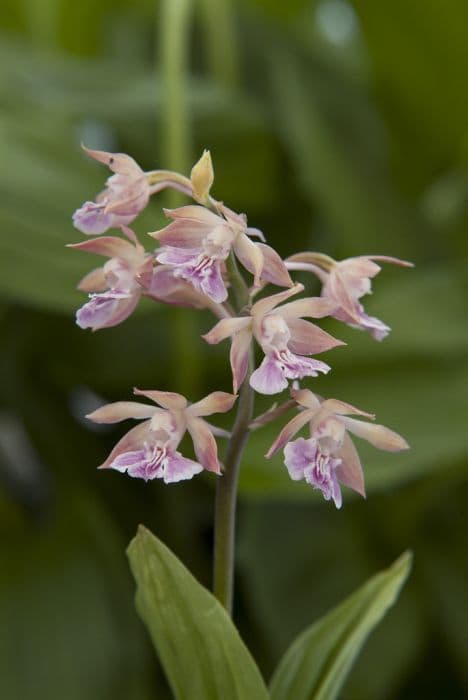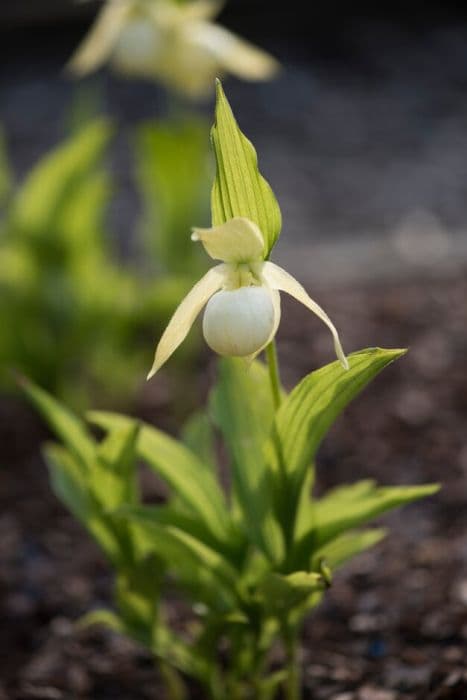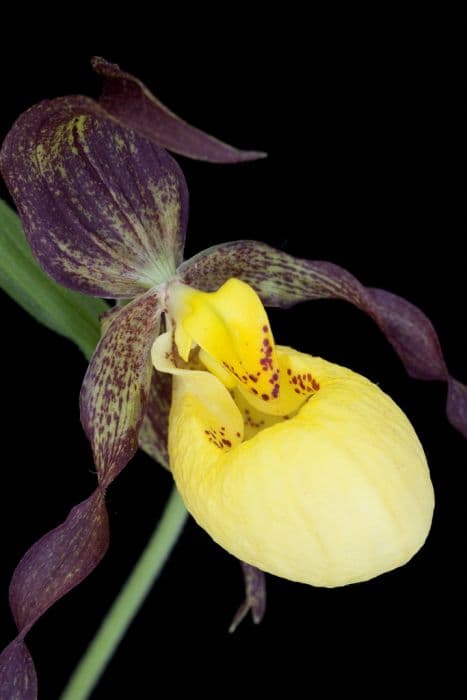Fairy Slipper Calypso bulbosa

ABOUT
The plant known as the fairy slipper orchid presents a delicate and striking appearance that is noted for its unique floral structure. It possesses a solitary, vibrant purple-pink blossom that resembles a slipper, a reference that gives the orchid its common name. The bloom cradles a darker purple, sometimes nearly maroon, spotted lip and features a twist resembling that of a spiral. The fairy slipper orchid's blossoms sit atop a slender, erect stem which arises from a base of green, oblong leaves. These leaves typically grow in a pair and lie close to the ground, often with a glossy appearance. The overall visual effect of the fairy slipper orchid is one of subtle beauty, marked by the contrast between its vivid flowers and the understated elegance of its foliage.
About this plant
 Names
NamesFamily
Orchidaceae.
Synonyms
Calypso Orchid, Fairy Slipper, Venus's Slipper, Deer's Head Orchid.
Common names
Cytherea bulbosa, Cypripedium calypso, Calypso occidentalis, Calypso americana, Calypso borealis, Calypso easterniana, Norna amabilis, Orchis bulbosa, Arethusa calypso.
 Toxicity
ToxicityTo humans
The plant known commonly as the Calypso orchid is not widely recognized for being toxic to humans. There is little available evidence suggesting that the Calypso orchid has any significant toxic properties that would lead to poisoning upon ingestion. As a result, there are no well-documented symptoms of poisoning from this plant.
To pets
Similar to its effects on humans, the Calypso orchid is not commonly associated with toxicity in pets. There is no substantial evidence or well-known reports of pets being poisoned by ingesting parts of the Calypso orchid. Consequently, there are no specific symptoms of poisoning that have been reliably attributed to this plant in pets.
 Characteristics
CharacteristicsLife cycle
Perennials
Foliage type
Deciduous
Color of leaves
Green
Flower color
Pink
Height
4 inches (10 cm)
Spread
2 inches (5 cm)
Plant type
Herb
Hardiness zones
3
Native area
North America
Benefits
 General Benefits
General Benefits- Ecosystem Balance: Calypso orchid supports local ecosystems by providing habitat and food for certain insects and pollinators.
- Aesthetic Value: With its attractive pink to purple flowers, the Calypso orchid adds natural beauty to the environments it inhabits, which can enhance human appreciation and enjoyment of nature.
- Biodiversity Support: The Calypso orchid contributes to plant diversity within its native forest floor habitats, which is important for a resilient ecosystem.
- Soil Health: As a part of the forest understory, Calypso orchid plays a role in the delicate soil ecosystems, helping to maintain soil structure and health.
- Educational Interest: Calypso orchid can serve as a subject for botanical study and education due to its unique growing requirements and interactions with its environment.
- Conservation Indicator: As Calypso orchid is sensitive to ecological changes, it can serve as an indicator species for the health of its ecosystem, highlighting the need for conservation efforts.
- Cultural Significance: For many indigenous groups and local communities, the Calypso orchid may hold cultural significance and is part of their natural heritage.
 Medical Properties
Medical PropertiesThis plant is not used for medical purposes.
 Air-purifying Qualities
Air-purifying QualitiesThis plant is not specifically known for air purifying qualities.
 Other Uses
Other Uses- Calypso Orchid, also known as fairy slipper, can be used in ornamental terrariums, adding a unique and delicate touch to miniature indoor ecosystems.
- The plant can serve as a symbol in art and literature, often representing beauty and rarity due to its unique appearance and relatively uncommon occurrence.
- The fairy slipper is sometimes used in photography workshops and nature classes to teach macro photography and the importance of natural light in capturing plant details.
- In colder regions, growing Calypso Orchid indoors can provide a welcome reminder of spring during the winter months due to its early blooming season.
- Environmental education programs utilize the Calypso Orchid as an example of a species that relies on specific mycorrhizal fungi, highlighting the complexity of ecological relationships.
- The plant has been used as a muse for botanical illustrators and artists, seeking to capture its intricate shapes and vibrant colors.
- Fairy slipper themes can be found in jewelry design, where the orchid’s shape is stylized in earrings, pendants, and brooches.
- Conservation efforts for the Calypso Orchid can involve citizen science projects, where volunteers help to monitor populations and flowering times.
- In landscaping, although challenging to cultivate, the plant can be used in specialized native plant gardens to create naturalized woodland settings.
- The fairy slipper, due to its specific habitat requirements, serves as an indicator species for ecologists studying the health of forest ecosystems.
Interesting Facts
 Feng Shui
Feng ShuiThe Fairy Slipper Orchid is not used in Feng Shui practice.
 Zodiac Sign Compitability
Zodiac Sign CompitabilityThe Fairy Slipper Orchid is not used in astrology practice.
 Plant Symbolism
Plant Symbolism- Femininity: Due to its delicate and graceful orchid blooms, Calypso bulbosa, commonly known as Fairy Slipper or Calypso Orchid, is often associated with femininity and the soft, nurturing qualities typically attributed to it.
- Rarity and Preciousness: As a rare species often found in specific ecosystems, the Fairy Slipper symbolizes preciousness and the value of rare or unique attributes.
- Beauty and Charm: The exquisite beauty of its flower represents charm and physical attractiveness, reflecting the allure of natural beauty.
- Connection with the Mystical: Named after the nymph Calypso from Greek mythology, this plant signifies a connection with myth and folklore, embodying the mysterious and often-hidden aspects of nature.
- Fragility of Nature: Because the Calypso Orchid thrives in undisturbed environments, it symbolizes the fragility of ecosystems and the need for environmental preservation and careful stewardship.
 Water
WaterThe fairy slipper orchid, commonly known as Calypso bulbosa, requires careful watering that keeps its environment consistently moist but never soggy, mimicking its natural woodland habitat. Water the plant when the top inch of the soil feels dry, which depending on the environment, may be about once a week. Use lukewarm water, and gently pour it around the base of the plant, avoiding the leaves, to the equivalent of approximately 4 ounces per watering for a standard household pot. Increase the frequency slightly during the active growing season in spring and summer, and reduce it in the fall and winter months when the plant enters a dormant period.
 Light
LightThe fairy slipper orchid thrives in dappled sunlight, similar to the light conditions of its native forest floors. Place it in a spot where it receives bright, indirect light but is shielded from direct sunlight, which can scorch its leaves. East or north-facing windows with sheer curtains are usually ideal to provide these light conditions.
 Temperature
TemperatureThe fairy slipper orchid prefers cool to moderate temperatures, with ideal conditions ranging between 60 to 70 degrees Fahrenheit. It can withstand minimum temperatures of approximately 50 degrees Fahrenheit and maximum temperatures up to about 80 degrees Fahrenheit. Consistent temperatures within this range promote healthy growth and flowering.
 Pruning
PruningPruning is typically not necessary for the fairy slipper orchid, as the plant does not have a large growth habit that requires shaping. If any dead or damaged parts are present, they should be gently removed to maintain plant health. The best time for any necessary pruning is immediately after the flowering season when the plant begins to enter its dormant phase.
 Cleaning
CleaningAs needed
 Soil
SoilThe best soil mix for the Fairy Slipper Orchid should be well-draining and rich in organic matter, similar to a mix used for orchids or woodland plants. The pH should range between 5.5 and 7 for optimal growth. A blend of fine bark, peat moss, and perlite often works well for this orchid species.
 Repotting
RepottingFairy Slipper Orchids rarely need repotting and can often be left undisturbed for years. Repotting is typically necessary only if the growing medium has broken down or if the plant has outgrown its container. Repotting should be done with care to avoid damaging the delicate roots.
 Humidity & Misting
Humidity & MistingFairy Slipper Orchids thrive in high humidity conditions, ideally between 40% to 70%. They benefit from a moist environment that mimics their native woodland habitats. Avoid placing them in overly dry environments which can hinder their growth.
 Suitable locations
Suitable locationsIndoor
Place in low-light space with high humidity and cool temps.
Outdoor
Grow in dappled shade, in humus-rich, moist soil.
Hardiness zone
3-9 USDA
 Life cycle
Life cycleCalypso bulbosa, commonly known as the Fairy Slipper or Calypso Orchid, begins its life as a seed, dispersed by wind or water. Upon finding suitable symbiotic fungal partners in a moist, well-drained soil, the seed germinates and forms a protocorm, relying on the fungus for nutrients until it can photosynthesize. As it matures, Calypso bulbosa develops a single oval bulb, which serves as a storage organ. Each year, typically in the spring, a single leaf emerges first, followed by a delicate, solitary purple-pink blossom with a pouch-shaped lip. After flowering, the plant enters a period of dormancy, where the above-ground parts die back and the bulb lies dormant through the summer and winter. Once the conditions are right again for growth, the cycle repeats with the emergence of new leaf and flower growth in the following spring.
 Propogation
PropogationPropogation time
Spring to Summer
The most popular method of propagation for the Fairy Slipper orchid, also known as Calypso bulbosa, is through seed dispersal in its natural habitat. However, this is extremely difficult to replicate in cultivation due to the orchid’s symbiotic relationship with mycorrhizal fungi which is essential for seed germination. For successful propagation, experienced growers might collect seed pods from existing plants and attempt to germinate the seeds in sterile laboratory conditions using specialized orchid media combined with the correct strain of symbiotic fungi. The process requires patience and a sterile environment to prevent fungal contamination that isn't beneficial. It's not generally done by casual gardeners due to the complexity and specific requirements of the genus. This method is mainly used by botanists and specialty growers who aim to conserve this species or use it for scientific study.









